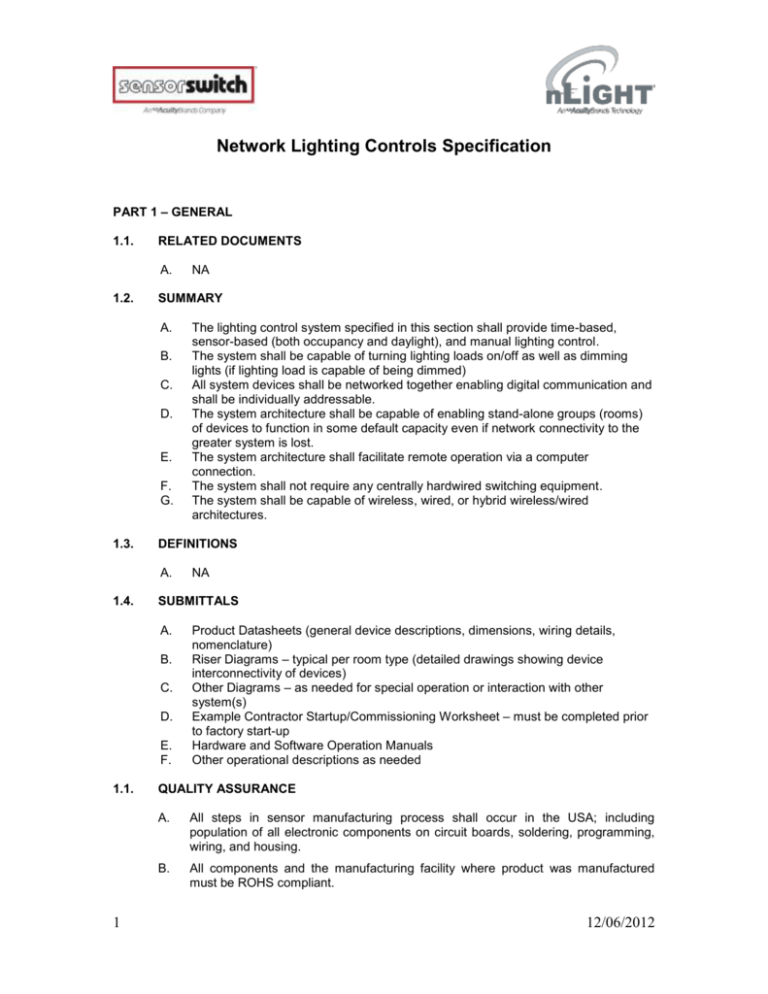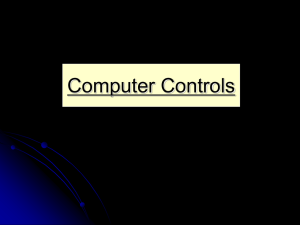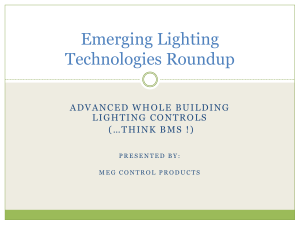nLight Specification
advertisement

Network Lighting Controls Specification PART 1 – GENERAL 1.1. RELATED DOCUMENTS A. 1.2. SUMMARY A. B. C. D. E. F. G. 1.3. B. C. D. E. F. 1 NA SUBMITTALS A. 1.1. The lighting control system specified in this section shall provide time-based, sensor-based (both occupancy and daylight), and manual lighting control. The system shall be capable of turning lighting loads on/off as well as dimming lights (if lighting load is capable of being dimmed) All system devices shall be networked together enabling digital communication and shall be individually addressable. The system architecture shall be capable of enabling stand-alone groups (rooms) of devices to function in some default capacity even if network connectivity to the greater system is lost. The system architecture shall facilitate remote operation via a computer connection. The system shall not require any centrally hardwired switching equipment. The system shall be capable of wireless, wired, or hybrid wireless/wired architectures. DEFINITIONS A. 1.4. NA Product Datasheets (general device descriptions, dimensions, wiring details, nomenclature) Riser Diagrams – typical per room type (detailed drawings showing device interconnectivity of devices) Other Diagrams – as needed for special operation or interaction with other system(s) Example Contractor Startup/Commissioning Worksheet – must be completed prior to factory start-up Hardware and Software Operation Manuals Other operational descriptions as needed QUALITY ASSURANCE A. All steps in sensor manufacturing process shall occur in the USA; including population of all electronic components on circuit boards, soldering, programming, wiring, and housing. B. All components and the manufacturing facility where product was manufactured must be ROHS compliant. 12/06/2012 1.2. C. In high humidity or cold environments, the sensors shall be conformably coated and rated for condensing humidity and -40 degree Fahrenheit (and Celsius) operation. D. All applicable products must be UL / CUL Listed or other acceptable national testing organization. COORDINATION A. B. C. 1.3. Coordinate lighting control components to form an integrated interconnection of compatible components. Coordinate lighting controls with BAS (if necessary) either through IP based intercommunication of system or hardwired auxiliary relay outputs. The installing contractor shall be responsible for a complete and functional system in accordance with all applicable local and national codes. WARRANTY A. All devices in lighting control system shall have a 5 year warranty. PART 2 – PRODUCTS 2.1. MANUFACTURERS A. 2.2. 2 This specification is based on the nLight® Network Control System from Sensor Switch, an Acuity Brands Company (800-727-7483, www.sensorswitch.com). SYSTEM REQUIREMENTS A. System shall have an architecture that is based upon three main concepts; 1) intelligent lighting control devices 2) standalone lighting control zones 3) network backbone for remote or time based operation. B. Intelligent lighting control devices shall consist of one or more basic lighting control components; occupancy sensors, photocell sensors, relays, dimming outputs, manual switch stations, and manual dimming stations. Combining one or more of these components into a single device enclosure should be permissible so as to minimize overall device count of system. C. System must interface directly with intelligent LED luminaires such that only CAT-5 cabling is required to interconnect luminaires with control components such as sensors and switches (see Networked LED Luminaire section) D. Intelligent lighting control devices shall communicate digitally, require <4 mA of current to function (Graphic wall stations excluded), and posses RJ-45 style connectors. E. Lighting control zones shall consist of one or more intelligent lighting control components, be capable of stand-alone operation, and be capable of being connected to a higher level network backbone. F. Devices within a lighting control zone shall be connected with CAT-5e low voltage cabling in any order. G. Lighting control zone shall be capable of automatically configuring itself for default operation without any start-up labor required. 12/06/2012 H. Individual lighting zones must continue to provide a user defined default level of lighting control in the event of a system communication failure with the backbone network or the management software becoming unavailable. I. Power for devices within a lighting control zone shall come from either resident devices already present for switching (relay device) or dimming purposes, or from the network backbone. Standalone “bus power supplies” shall not be required in all cases. J. All switching and dimming for a specific lighting zone shall take place within the devices located in the zone itself (i.e. not in a remotely located devices such as panels) to facilitate system robustness and minimize wiring requirements. Specific applications that require centralized or remote switching shall be capable of being accommodated. K. System shall have one or more primary wall mounted network control “gateway” devices that are capable of accessing and controlling connected system devices and linking into an Ethernet LAN. L. System shall use “bridge” devices that route communication and distribute power for up to 8 directly connected lighting zones together for purposes of decreasing system wiring requirements. M. System shall be capable of wirelessly connecting a lighting zone to a WiFi (802.11n) wireless data network for purposes of eliminating the “bridge” devices and all cabling that connects zones to bridge devices. N. WiFi enabled devices shall be able to detect when WiFi network is down and revert to a user directed default state. O. WiFi-enabled devices shall be capable of current monitoring P. WiFi-enabled devices shall utilize WPA2 AES encryption Q. WiFi-enabled devices shall be able to connect to 802.11b/g/n WiFi networks R. WiFi-enabled devices shall have at least one local RJ-45 port for communicating with nonWiFi-enabled system devices S. System shall have a web-based software management program that enables remote system control, status monitoring, and creation of lighting control profiles. T. Individual lighting zones shall be capable of being segmented into several “local” channels of occupancy, photocell, and switch functionality for more advanced configurations and sequences of operation. U. Devices located in different lighting zones shall be able to communicate occupancy, photocell, and switch information via either the wired or WiFi backbone. V. System shall be capable of operating a lighting control zone according to several sequences of operation. System shall be able to change a spaces sequence of operation according to a time schedule so as to enable customized time-of-day, day-of-week utilization of a space. Note operating modes should be utilized only in manners consistent with local energy codes. a. Auto-On / Auto-Off (via occupancy sensors) Zones with occupancy sensors automatically turn lights on when occupant is detected. 3 12/06/2012 Zones with occupancy and/or photocell sensors turn lights off when vacancy or sufficient daylight is detected. Pressing a switch will turn lights off. The lights will remain off regardless of occupancy until switch is pressed again, restoring the sensor to Automatic On functionality. b. Manual-On / Auto-Off (also called Semi-Automatic) Pushing a switch will turn lights on. Zones with occupancy and/or photocell sensors turn lights off when vacancy or sufficient daylight is detected. c. Manual-On to Auto-On/Auto-Off Pushing a switch will turn lights on. After initial lights on, zones with occupancy and/or photocell sensors turn lights on/off according to occupancy/vacancy and/or daylight conditions. Sequence can be reset via scheduled (ex. daily each morning) events d. Auto-to-Override On Zones with occupancy sensors automatically turn lights on when occupant is detected. Zone lighting then goes into an override on state for a set amount of time or until the next time event returns the lighting to an auto-off style of control. Sequence can be reset via scheduled (ex. daily each morning) events e. Manual-to-Override On Pushing a switch will turn lights on. Zone lighting then goes into an override on state for a set amount of time or until the next time event returns the lighting to an auto-off style of control. Sequence can be reset via scheduled (ex. daily each morning) events f. Auto On / Predictive Off Zones with occupancy sensors automatically turn lights on when occupant is detected. Zones with occupancy and/or photocell sensors turn lights off when vacancy or sufficient daylight is detected. If switch is pressed, lights turn off and a short “exit timer” begins. After timer expires, sensor scans the room to detect whether occupant is still present. If no occupancy is detected, zone returns to auto-on. If occupancy is detected, lights must be turned on via the switch. g. Multi-Level Operation (multiple lighting levels per manual button press) Operating mode designed specifically for bi-level applications Enables the user to cycle through the up to four potential on/off lighting states using only a single button. Eliminates user confusion as to which of two buttons controls which load Three different transition sequences are available in order to comply with energy codes or user preference) Mode available as a setting on all nLight devices that have single manual on/off switch (ex. nWSX, nPODM, nPODM-DX). Depending on the sequence selected, every button push steps through relays states according to below table In addition to achieving bi-level lighting control by switching loads with relays, the ability to command dimming outputs to “step” in a sequence that achieves bi-level operation is present. 4 12/06/2012 Alternating Sequence Full On Sequence 3 Step On Sequence Sequence State # Relay 1 Relay 2 Relay 1 Relay 2 Relay 1 Relay 2 1 On Off On Off On Off 2 Off On - - Off On 3 - - On On On On 4* Off Off Off Off Off Off (*step only present for devices without separate off button) W. A taskbar style desktop application shall be available for personal lighting control. X. An application that runs on “smart” handheld devices (such as an Apple ® IPhone®) shall be available for personal lighting control. Y. Control software shall enable logging of system performance data and presenting useful information in a web-based graphical format and downloadable to .CSV files. Z. Control software shall enable integration with a BMS via BACnet IP. AA. System shall provide the option of having pre-terminated plenum rated CAT-5 cabling supplied with hardware. 2.3. INDIVIDUAL DEVICE SPECIFICATIONS A. Control Module (Gateway) a. Control module shall be a device that facilitates communication and time-based control of downstream network devices and linking into an Ethernet. b. Devices shall have a user interface that is capable of wall mounting, powered by low voltage, and have a touch screen. c. Control device shall have three RJ-45 ports for connection to other backbone devices (bridges) or directly to lighting control devices. d. Device shall automatically detect all devices downstream of it. e. Device shall have a standard and astronomical internal time clock. f. Device shall have one RJ-45 10/100 BaseT Ethernet connection. g. Device shall have a USB port h. Each control gateway device shall be capable of linking 1500 devices to the management software. i. Device shall be capable of using a dedicated or DHCP assigned IP address. j. Network Control Gateway device shall be the following Sensor Switch model Series: nGWY2 B. 5 Networked System Occupancy Sensors 12/06/2012 a. Occupancy sensors system shall sense the presence of human activity within the desired space and fully control the on/off function of the lights. b. Sensors shall utilize passive infrared (PIR) technology, which detects occupant motion, to initially turn lights on from an off state; thus preventing false on conditions. Ultrasonic or Microwave based sensing technologies shall not be accepted. c. For applications where a second method of sensing is necessary to adequately detect maintained occupancy (such as in rooms with obstructions), a sensor with an additional “dual” technology shall be used. d. Dual technology sensors shall have one of its two technologies not require motion to detect occupancy. Acceptable dual technology includes PIR/Microphonics (also known as Passive Dual Technology or PDT) which both looks for occupant motion and listens for sounds indicating occupants. Sensors where both technologies detect motion (PIR/Ultrasonic) shall not be acceptable. e. All sensing technologies shall be acoustically passive meaning they do not transmit sounds waves of any frequency (for example in the Ultrasonic range), as these technologies have the potential for interference with other electronic devices within the space (such as electronic white board readers). Acceptable detection technologies include Passive Infrared (PIR), and/or Microphonics technology. Ultrasonic or Microwave based sensing technologies shall not be accepted. f. Sensors shall be available with zero, one, or two integrated Class 1 switching relays, and up to one 0-10 VDC dimming output. Sensors shall be capable of switching 120 / 277 / 347 VAC. Load ratings shall be 800 W @ 120 VAC, 1200 W @ 277 VAC, 1500 W @ 347 VAC, and ¼ HP motor. Relays shall be dry contacts. g. Sensors shall be available with one or two occupancy “poles”, each of which provides a programmable time delay. h. Sensors shall be available in multiple lens options which are customized for specific applications. i. Communication and Class 2 low voltage power shall be delivered to each device via standard CAT-5 low voltage cabling with RJ-45 connectors. j. All sensors shall have two RJ-45 ports or capable of utilizing a splitter. k. All sensors shall have the ability to detect when it is not receiving valid communication (via CAT-5 connections) and blink its LED in a pattern to visually indicate of a potential wiring issue l. Every sensor parameter shall be available and configurable remotely from the software and locally via the device push-button. m. Sensors shall be able to function together with other sensors in order to provide expanded coverage areas by simply daisy-chain wiring together the units with CAT-5 cabling. n. Sensors shall be equipped with an automatic override for 100 hour burn-in of lamps. This feature must be available at any time for lamp replacements. o. Wall switch sensors shall recess into single-gang switch box and fit a standard GFI opening. p. Wall switch sensors must meet NEC grounding requirements by providing a dedicated ground connection and grounding to mounting strap. Line and load wire connections shall be interchangeable. Sensor shall not allow current to pass to the load when sensor is in the unoccupied (Off) condition. 6 12/06/2012 q. Wall switch sensors shall have optional features for photocell/daylight override, vandal resistant lens, and low temperature/high humidity operation. r. Wall switch sensors shall be available in four standard colors (Ivory, White, Light Almond, Gray) s. Wall switch sensors shall be available with optional raise/lower dimming adjustment controls t. Wall switch sensors shall be the following Sensor Switch model numbers, with device color and optional features as specified: nWSD or nWSX (PIR, 1 Relay) nWSD PDT or nWSX PDT (Dual Tech, 1 Relay) nWSD NL (PIR w/ Night Light, 1 Relay) nWSD PDT NL (Dual Tech w/ Night Light, 1 Relay) nWSX NL LV (PIR w/ Night Light, No Relay) nWSD PDT NL LV (Dual Tech w/ Night Light, No Relay) nWSD LV or nWSX LV (PIR, No Relay, Raise/Lower Dim Ctrl) nWSD PDT LV or nWSX PDT LV (Dual Tech w/ Night Light, No Relay, Raise/Lower Dim Ctrl) u. Network system shall have sensors that can be embedded into luminaire such that only the lens shows on luminaire face. v. Embedded sensors shall be capable of both PIR and Dual Technology occupancy detection w. Embedded sensors shall have an optional photocell x. Embedded sensors shall be the following Sensor Switch model number: nES 7 (PIR, No Relay) nES 7 ADCX (PIR w/ Photocell, No Relay) nES PDT 7 (Dual Technology, No Relay) nES PDT 7 ADCX (Dual Technology w/ Photocell, No Relay) y. Network system shall also have ceiling, fixture, recessed, & corner mounted sensors available. z. Fixture mount sensors shall be capable of powering themselves via a line power feed. aa. Sensors shall have optional features for photocell/daylight override, dimming control, and low temperature/high humidity operation. bb. Sensors with dimming can control 0 to 10 VDC dimmable ballasts by sinking up to 20 mA of Class 2 current (typically 40 or more ballasts). cc. Sensors shall be the following Sensor Switch model numbers, with device options as specified: Model # Series nCM(B) 9 nCM(B) 9 2P nCMR(B) 9 nCMR(B) 9 2P 7 Occupancy Poles 1 2 1 2 # of Relays 1 2 Lens Type Standard Standard Standard Standard Detection Technology PIR PIR PIR PIR 12/06/2012 nCM(B) PDT 9 nCM(B) PDT 9 2P nCMR(B) PDT 9 nCMR(B) PDT 9 2P nCM(B) 10 N nCM(B) 10 2P o nCMR(B) 10 t e nCMR(B) 10 2P : nCM(B) PDT 10 nCM(B) PDT 10 2P R nCMR(B) PDT 10 e nCMR(B) PDT 10 2P c nWV 16 e nWV s PDT 16 s nHW13 e nCM(B) 6 d nCMR(B) 6 nCMR(B) 6 2P N nCMR(B) 6 480 o 1 2 1 2 1 2 1 2 1 2 1 2 1 1 1 1 1 2 1 1 2 1 2 1 2 1 2 2 Standard Standard Standard Standard Extended Extended Extended Extended Extended Extended Extended Extended Wide View Wide View Hallway High Bay High Bay High Bay High Bay Dual Dual Dual Dual PIR PIR PIR PIR Dual Dual Dual Dual PIR Dual PIR PIR PIR PIR PIR te: Recessed mount versions of the above ceiling(fixture) mount versions also shall be available (e.g. nCMR(B) 9 => nRMR 9) bb. System shall have WiFi enabled fixture mountable sensors available. cc. Embedded sensors shall have an optional photocell and 0-10 VDC dimming output dd. WiFi enable sensors shall be one of the Sensor Switch model numbers: nCMRB 6 WIFI (PIR, w/ Relay) nCMRB 10 WIFI (PIR, w/ Relay) nCMRB 50 WIFI (PIR, w/ Relay) nCMRB 9 WIFI (PIR, w/ Relay) C. Networked System Daylight (Photocell and or Dimming) Sensors a. Photocell shall provide for an on/off set-point, and a deadband to prevent the artificial light from cycling. Delay shall be incorporated into the photocell to prevent rapid response to passing clouds. b. Photocell and dimming sensor’s set-point and deadband shall be automatically calibrated through the sensor’s microprocessor by initiating an “Automatic Setpoint Programming” procedure. Min and max dim settings as well as set-point may be manually entered. c. Deadband setting shall be verified and modified by the sensor automatically every time the lights cycle to accommodate physical changes in the space (i.e., furniture layouts, lamp depreciation, or lamp outages). d. Dimming sensors shall control 0 to 10 VDC dimmable ballasts by sinking up to 20 mA of class 2 current (typically 40 or more ballasts). e. Photocell and dimming sensors shall be equipped with an automatic override for 100 hour burn-in of lamps. This feature must be available at any time for lamp 8 12/06/2012 replacements. (Note: This function should be performed prior to any dimming of the lamps including the “auto set-point” setting.) f. Combination units that have all features of on/off photocell and dimming sensors shall also be available. g. A dual zone option shall be available for On/Off Photocell, Automatic Dimming Control Photocell, or Combination units. The second zone shall be capable of being controlled as an “offset” from the primary zone. h. Line voltage versions of the above described photocell and combination photocell/dimming sensors shall be capable of switching both 120 VAC, 277 VAC, and 347 VAC. Load ratings shall be 800 W @ 120 VAC, 1200 W @ 277 VAC, 1500 W @ 347 VAC, and ¼ HP motor load. Relays shall be dry contacts. i. Sensor shall be the following Sensor Switch model numbers, with device options as specified: nCM(B) PC (on/off)) nCM(B) ADC (dimming) nCM(B) PC ADC (on/off, 0-10 VDC dimming) nCMR(B) PC (on/off, single relay) nCMR(B) PC ADC (on/off, 0-10 VDC dimming, single relay) Note: Recessed mount versions of the above ceiling(fixture) mount versions also shall be available (e.g. nCMR(B) PC => nRMR PC) j. Network system shall have dimming photocells that can be embedded into luminaire such that only the lens shows on luminaire face. k. Embedded sensors shall be the following Sensor Switch model number: nES ADCX (Dimming Photocell) D. Networked System Power (Relay) Packs a. Power Pack shall incorporate one or more Class 1 relays and contribute low voltage power to the rest of the system. Secondary Packs shall incorporate the relay(s), shall have an optional 2nd relay, 0-10 VDC dimming output, or line voltage dimming output, but shall not be required to contribute system power. Power Supplies shall provide system power only, but are not required to switch line voltage circuit. Auxiliary Relay Packs shall switch low voltage circuits only. b. Power Packs shall accept 120 or 277 VAC (or optionally 347 VAC), be plenum rated, and provide Class 2 power to the system. c. All devices shall have two RJ-45 ports. d. Every Power Pack parameter shall be available and configurable remotely from the software and locally via the device push-button. e. Power Pack shall securely mount to junction location through a threaded ½ inch chase nipple or be capable of being secured within a luminaire ballast channel. Plastic clips into junction box shall not be accepted. All Class 1 wiring shall pass through chase nipple into adjacent junction box without any exposure of wire leads. Note: UL Listing under Energy Management or Industrial Control 9 12/06/2012 Equipment automatically meets this requirement, whereas Appliance Control Listing does not meet this safety requirement. f. When required by local code, Power Pack must install inside standard electrical enclosure and provide UL recognized support to junction box. All Class 1 wiring is to pass through chase nipple into adjacent junction box without any exposure of wire leads. g. Power Packs and Power Supplies shall be available that are WiFi enabled. h. Power (Secondary) Packs shall be available that provide up to 16 Amp switching of all lighting load types. i. Power (Secondary) Packs shall be available that provide up to 5 Amps switching of all lighting load types as well as 0-10 VDC dimming or fluorescent ballasts/LED drivers. j. Specific Secondary Packs shall be available that provide up to 5 Amps of switching as well as 0-10 VDC dimming of fluorescent ballasts/LED drivers. k. Specific Secondary Packs shall be available that provide up to 5 Amps of switching and can dim 120 VAC incandescent lighting loads or 120/277 VAC line voltage dimmable fluorescent ballasts (2-wire and 3-wire versions). l. Specific Secondary Packs shall be available that provide up to 5 Amps of switching and can dim 120/277 VAC magnetic low voltage transformers. m. Specific Secondary Packs shall be available that provide up to 4 Amps of switching and can dim 120 VAC electronic low voltage transformers. n. Specific Secondary Packs shall be available that provide up to 5 Amps of switching of dual phase (208/240/480 VAC) lighting loads. o. Specific Secondary Packs shall be available that require a manual switch signal (via a networked Wall Station) in order to close its relay. p. Specific Power/Secondary Packs shall be available that are UL924 listed for switching of Emergency Power circuits. q. Specific Secondary Packs shall be available that control louver/damper motors for skylights. r. Specific Secondary Packs shall be available that provide a pulse on/pulse off signal for purposes of controlling shade systems via relay inputs. s. Power (Relay) Packs and Supplies shall be the following Sensor Switch model Series: nPP16 (Power Pack w/ 16A relay) nPP16 WIFI (Power Pack w/ 16A relay, WIFI enabled) nEPP5 D (Power Pack w/ 5A relay and 0-10VDC dimming output) nSP16 (Secondary Pack w/ 16A relay) nSP5 2P (Secondary Pack w/ two 5A relays) nSP5 D (Secondary Pack w/ 5A relay and 0-10VDC dimming output) nPP16 ER (UL924 Listed Secondary Pack w/ 16A relay for switching emergency power circuits) nSP5 D ER (UL924 Listed Secondary Pack w/ 5A relay and 0-10VDC dimming output for switching emergency power circuits) nSP5 PCD 2W (Secondary Pack w/ 5A relay and incandescent dimming or 2-wire line voltage fluorescent dimming output) nSP5 PCD 3W (Secondary Pack w/ 5A relay and 3-wire line voltage fluorescent dimming output) 10 12/06/2012 nSP5 PCD MLV (Secondary Pack w/ 5A relay and magnetic low voltage dimming output) nSP5 PCD ELV 120 (Secondary Pack w/ 4A relay and electronic low voltage dimming output) nSP5 480 (Secondary Pack w/ 5A relay for switching 208/240/480 VAC loads nSP5 2P LVR (Louver/Damper Control Pack nSHADE (Pulse On/Off Control Pack nPS 80 (Auxiliary Bus Power Supply) nPS 80 WIFI (Auxiliary Bus Power Supply, WiFi enabled) nAR 40 (Low voltage auxiliary relay pack) E. Networked System Relay & Dimming Panels a. Panel shall incorporate up to 4 normally closed latching relays capable of switching 120/277 VAC or up to 2 Dual Phase relays capable of switching 208/240/480 VAC loads. b. Relays shall be rated to switch up to a 30A ballast load at 277 VAC. c. Panel shall provide one 0-10VDC dimming output paired with each relay. d. Panel shall power itself from an integrated 120/277 VAC supply. e. Panel shall be capable of operating as either two networked devices or as one. f. Panel shall supply current limited low voltage power to other networked devices connected via CAT-5. g. Panel shall provide auxiliary low voltage device power connected wired directly to a dedicated terminal connection h. Power (Relay) Packs and Supplies shall be the following Sensor Switch model numbers: nPANEL 4 (Panel w/ four 120/277 VAC relays and four 0-10 VDC dimming outputs) nPANEL 2 480 (Panel w/ two dual phase relays (208/240/480 VAC) and two 0-10 VDC dimming outputs) F. Networked Auxiliary Input / Output (I/O) Devices a. Devices shall be plenum rated and be inline wired, screw mountable, or have an extended chase nipple for mounting to a ½” knockout. b. Devices shall have two RJ-45 ports c. Communication and low voltage power shall be delivered to each device via standard CAT-5 low voltage cabling with RJ-45 connectors. d. Specific I/O devices shall have a dimming control output that can control 0-10 VDC dimmable ballasts or LED drivers by sinking up to 20 mA of current (typically 40 or more ballasts). e. Specific I/O devices shall have an input that read a 0-10 VDC signal from an external device. f. Specific I/O devices shall have a switch input that can interface with either a maintained or momentary switch and run a switch event, run a local/remote control profile, or raise/lower a dimming output g. Specific I/O devices shall sense state of low voltage outdoor photocells 11 12/06/2012 h. Specific I/O devices shall enable RS-232 communication between lighting control system and Touch Screen based A/V control systems. i. Specific I/O devices shall sense . j. Auxiliary Input/Output Devices shall be the following Sensor Switch model numbers: nIO D (I/O device with 0-10 dimming output) nIO 1S or nIO RLX (I/O device with contact closure or 0-10VDC dimming input ) nIO NLI (Input device for detecting state of low voltage outdoor photocell; sold in nIO PC KIT only) nIO X (Interface device for communicating with RS-232 enabled AV Touch Screens G. Networked LED Luminaires a. Networked LED luminaire shall have a mechanically integrated control device b. Networked LED luminaire shall have two RJ-45 ports c. Networked LED luminaire shall be able to digitally network directly to other network control devices (sensors, photocells, switches, dimmers) d. Networked LED luminaire shall provide low voltage power to other networked control devices e. System shall be able to turn on/off LED luminaire without using a relay f. System shall be able to maintain constant lumen output over the specified life of the LED luminarie (also called lumen compensation) by varying the input control power (and thus saving up to 20% power usage). g. System shall indicate (via a blink warning) when the LED luminaire has reached its expected life (in hrs). k. LED Luminaires shall be the following Lithonia model families: RTLED TLED VLED ACLED AL LED WLED STLED MINO H. Networked System Wall Switches & Dimmers a. Devices shall recess into single-gang switch box and fit a standard GFI opening. b. Devices shall be available with zero or one integrated Class 1 switching relay. c. Communication and low voltage power shall be delivered to each device via standard CAT-5 low voltage cabling with RJ-45 connectors. d. All sensors shall have two RJ-45 ports. 12 12/06/2012 e. All devices shall provide toggle switch control. Dimming control and low temperature/high humidity operation are available options. f. Devices shall be available in four colors (Ivory, White, Light Almond, Gray). g. Devices with dimming control outputs can control 0-10 VDC dimmable ballasts by sinking up to 20 mA of current (typically 40 or more ballasts). h. Devices with capacitive touch buttons shall provide audible user feedback with different sounds for on/off, raise/lower, start-up, and communication offline. i. Devices with mechanical push-buttons shall provide tactile and LED user feedback. j. Devices with mechanical push-buttons shall be made available with custom button labeling k. Devices with a single on button shall be capable of selecting all possible lighting combinations for a bi-level lighting zone such that the user confusion as to which of two buttons (as is present in multi-button scenarios) controls which load is eliminated. l. Wall switches & dimmers shall be the following Sensor Switch model numbers, with device options as specified: nPOD (single on/off, capacitive touch, audible user feedback) nPOD 2P (dual on/off, capacitive touch, audible user feedback) nPODR (single on/off, one relay, capacitive touch, audible user feedback) nPODM (single on/off, push-buttons, LED user feedback) nPODM 2P (dual on/off, push-buttons, LED user feedback) nPODM DX (single on/off, single dimming raise/lower, push-buttons, LED user feedback) nPODM 2P DX (dual on/off, dual dimming raise/lower, push-buttons, LED user feedback) nPODM 4P (quad on/off, push-buttons, LED user feedback) nPODM 4P DX (quad on/off, quad dimming raise-lower, push-buttons, LED user feedback) I. Networked System Graphic Wall Station a. Device shall have a 3.5” full color touch screen for selecting up to 8 programmable lighting control presets or acting as up to 16 on/off/dim control switches. b. Device shall enable configuration of lighting presets, switched, and dimmers via password protected setup screens. c. Device shall enable user supplied .jpg screen saver image to be uploaded. d. Device shall surface mount to single-gang switch box e. Device shall have a micro-USB style connector for local computer connectivity. f. Device shall have two RJ-45 ports for communication g. Device shall be the following Sensor Switch model number: nPOD GFX J. 13 Networked System Scene Controllers 12/06/2012 a. Device shall have two to four buttons for selecting programmable lighting control profiles or acting as on/off switches. b. Device shall recess into single-gang switch box and fit a standard GFI opening. c. Devices shall provide LED user feedback. d. Communication and Class 2 low voltage power shall be delivered to each device via standard CAT-5 low voltage cabling with RJ-45 connectors. e. All sensors shall have two RJ-45 ports. f. Device shall be capable of reprogramming other devices in its zone so as to implement user selected lighting scene. g. Device shall be capable of selecting a lighting profile be run by the system’s upstream Gateway so as to implement selected lighting profile across multiple zones (and not just its local zone). h. Device shall have LEDs indicating current selection. i. Scene Selector device shall be the following Sensor Switch model number: nPODM nPODM nPODM nPODM K. 2S (2 Scene, push-button) 4S (4 Scene, push-button) 4S DX (4 Scene, push-button, On/Off/Raise/Lower) 4L DX (4 Adjustable Presets, push-button, On/Off/Raise/Lower) Communication Bridges a. Device shall surface mount to a standard 4” x 4” square junction box. b. Device shall have 8 RJ-45 ports. c. Device shall be capable of aggregating communication from multiple lighting control zones for purposes of minimizing backbone wiring requirements back to Control Gateway. d. Device shall be powered with Class 2 low voltage supplied locally via a directly wired power supply or delivered via a CAT-5 cabled connection. e. Device shall be careful of redistributing power from its local supply and connect lighting control zones with excess power to lighting control zones with insufficient local power. This architecture also enables loss of power to a particular area to be less impactful on network lighting control system. f. Communication Bridge devices shall be the following Sensor Switch model numbers: nBRG 8 (8 Ports) 2.4. LIGHTING CONTROL PROFILES A. B. C. D. E. 14 Changes to the operation of the system shall be capable of being made in real-time or scheduled via lighting control profiles. These profiles are outlines of settings that direct how a collection of devices function for a defined time period. Lighting control profiles shall be capable of being created and applied to a single device, zone of devices, or customized group of zones. All relays and dimming outputs shall be capable of being scheduled to track or ignore information regarding occupancy, daylight, and local user switches via lighting control profiles. Every device parameter (e.g. sensor time delay and photocell set-point) shall be configurable via a lighting control profile. All lighting control profiles shall be stored on the network control gateway device and on the software’s host server. 12/06/2012 F. G. H. I. J. Lighting control profiles shall be capable of being scheduled to run according to the following calendar options: start date/hour/minute, end date/hour/minute, and sunrise/sunset +/- timed offsets. Sunrise/sunset times shall be automatically derived from location information using an astronomical clock. Daylight savings time adjustments shall be capable of being performed automatically, if desired. Lighting control profile schedules shall be capable of being given the following recurrence settings: daily, weekday, weekend, weekly, monthly, and yearly. Software shall provide a graphical tool for easily viewing scheduled lighting control profiles. 2.5. MANAGEMENT SOFTWARE A. B. C. D. E. F. G. H. I. J. Every device parameter (e.g. sensor time delay and photocell set-point) shall be available and configurable remotely from the software The following status monitoring information shall be made available from the software for all devices for which it is applicable: current occupancy status, current PIR Status, current Microphonics Status, remaining occupancy time delay(s), current photocell reading, current photocell inhibiting state, photocell transitions time remaining, current dim level, device temperature, and device relay state(s). The following device identification information shall be made available from the software: model number, model description, serial number, manufacturing date code, custom label(s), and parent network device. A printable network inventory report shall be available via the software. A printable report detailing all system profiles shall be available via the software. Software shall require all users to login with a User Name and Password. Software shall provide at least three permission levels for users. All sensitive stored information and privileged communication by the software shall be encrypted. All device firmware and system software updates must be available for automatic download and installation via the internet. Software shall be capable of managing systems interconnected via a WAN (wide area network) 2.6. BMS COMPATIBILITY A. B. C. System shall provide a BACnet IP gateway as a downloadable software plug-in to its management software. No additional hardware shall be required. BACnet IP gateway software shall communicate information gathered by networked system to other building management systems. BACnet IP gateway software shall translate and forward lighting relay and other select control commands from BMS system to networked control devices. 2.7. SYSTEM ENERGY ANALYSIS & REPORTING SOFTWARE A. B. C. 15 System shall be capable of reporting lighting system events and performance data back to the management software for display and analysis. Intuitive graphical screens shall be displayed in order to facilitate simple viewing of system energy performance. An “Energy Scorecard” shall be display that shows calculated energy savings in dollars, KWHr, or CO2. 12/06/2012 D. E. F. G. H. I. J. K. Software shall calculate the allocation of energy savings to different control measures (occupancy sensors, photocells, manual switching, etc). Energy savings data shall be calculated for the system as a whole or for individual zones. A time scaled graph showing all relay transitions shall be presented. A time scaled graph showing a zones occupancy time delay shall be presented A time scaled graph showing the total light level shall be presented. User shall be able to customize the baseline run-time hours for a space. User shall be able to customize up to four time-of-day billing rates and schedules. Data shall be made available via a .CSV file 2.8. START-UP & SUPPORT FEATURES A. B. C. D. E. F. To facilitate start-up, all devices daisy-chained together (using CAT-5) shall automatically be grouped together into a functional lighting control zone. All lighting control zones shall be able to function according to default settings once adequate power is applied and before any system software is installed. Once software is installed, system shall be able to auto-discover all system devices without requiring any commissioning. All system devices shall be capable of being given user defined names. All devices within the network shall be able to have their firmware reprogrammed remotely and without being physically uninstalled for purposes of upgrading functionality at a later date. All sensor devices shall have the ability to detect improper communication wiring and blink its LED in a specific cadence as to alert installation/startup personnel. End of Section 16 12/06/2012







